List of charts and tables
Charts
International economy
1. Selected international indicators 36
National accounts
2. Contributions to trend GDP growth 38
Tables
National accounts
1. Components of Gross Domestic Product 39
2. Contributions to change in Gross Domestic Product 40
3. Gross value-added by industry 41
Incomes, Costs and Prices
4. Real household income 42
5. Wages, labour costs and company income 43
6. Prices 44
7. Labour market 45
External sector
8. Current account 46
9. Australia's external liabilities 47
10. Australia's income flows 48
11. Selected economic indicators 49
Key to tables
n.a. not available
n.y.a. not yet available
.. change less than 0.05 per cent
Chart 1: Selected international indicators
Panel A: Short-term interest rates(a)
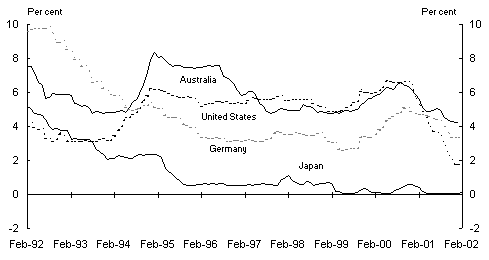
(a) Short-term interest rates are monthly averages and are defined as follows: US - 3 month certificates of deposits, Japan - 3-month certificates of deposit, Australia - 90 day bank accepted bills and Germany - 3 month FIBOR.
Source: OECD Main Economic Indicators.
Panel B: Real output(a)
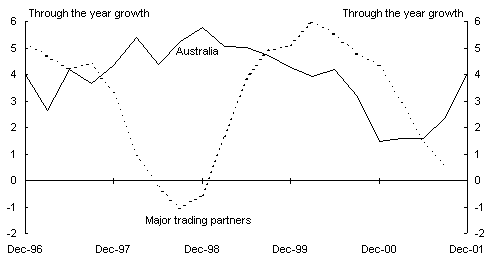
(a) Seasonally adjusted real GDP growth for each major trading partner is weighted by their respective shares of total Australian merchandise exports averaging from 1998-99 to 2000-01. Major trading partners are Japan, US, South Korea, New Zealand, China, Taiwan, Singapore, UK, Hong Kong, Indonesia, Malaysia, Italy, Thailand, Canada, Germany, The Philippines and France.
Panel C: Current account balances(a)

(a) Data are seasonally adjusted.
Source: Data are from statistical agencies of respective countries, except for Germany which is from the OECD Main Economic Indicators.
Panel D: Consumer price inflation(a)
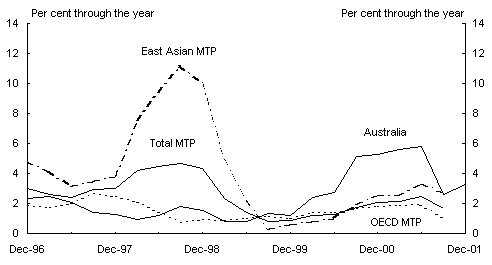
(a) The aggregate inflation rates are derived from the weighted average of inflation rates of individual trading partners, with the weights being their respective shares of Australian total merchandise trade from 1998-99 to 2000-01. Major trading partners are Japan, US, South Korea, New Zealand, China, Taiwan, Singapore, UK, Hong Kong, Indonesia, Malaysia, Italy, Thailand, Canada, Germany, the Philippines and France.
Source: Data for US, Japan, Germany, UK, New Zealand, Canada, South Korea, Singapore, Indonesia, Taiwan and Hong Kong are from the ABS All Groups CPI (excluding housing) measure. For the rest of Australia's MTP (France, Italy, China, Malaysia, Thailand and the Philippines), the CPI are from each country's respective all groups CPI series which exclude the effects of mortgage interest rate changes.
Chart 2: Contributions to trend quarterly GDP growth
(Chain volume measures)
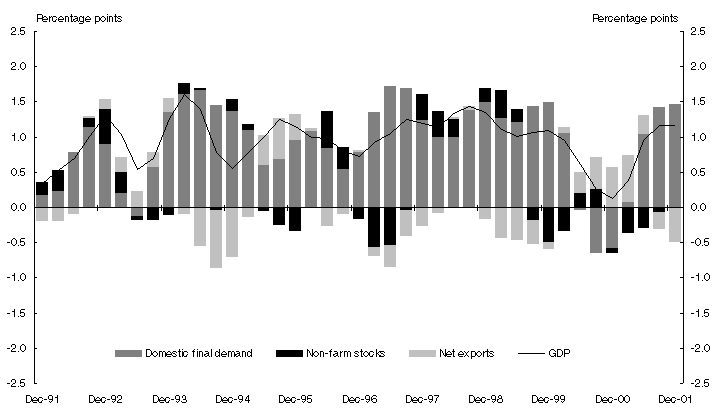
Source: ABS Cat. No. 5206.0.
Table 1: Components of Gross Domestic Product (chain volume measures)
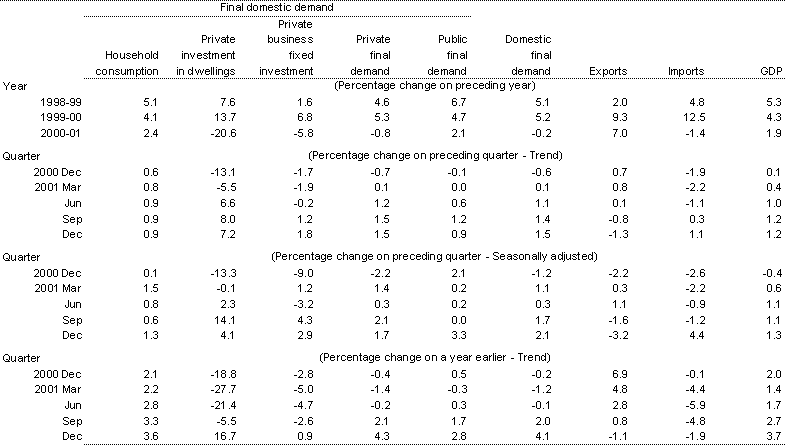
Source: ABS Cat. No. 5206.0.
Table 2: Contributions to change in Gross Domestic Product (chain volume measures)
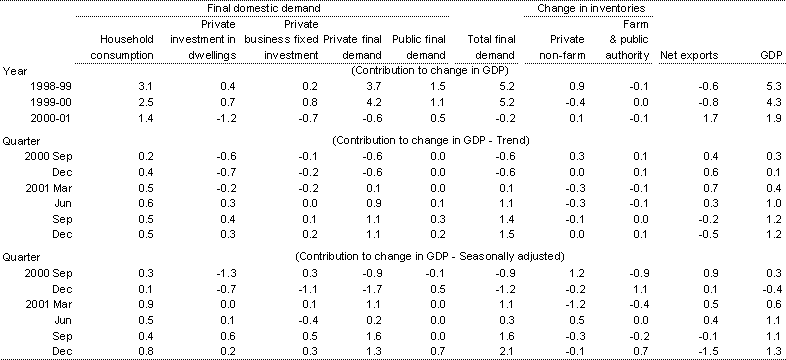
Source: ABS Cat. No. 5206.0.
Table 3: Gross value-added by industry (chain volume measures)
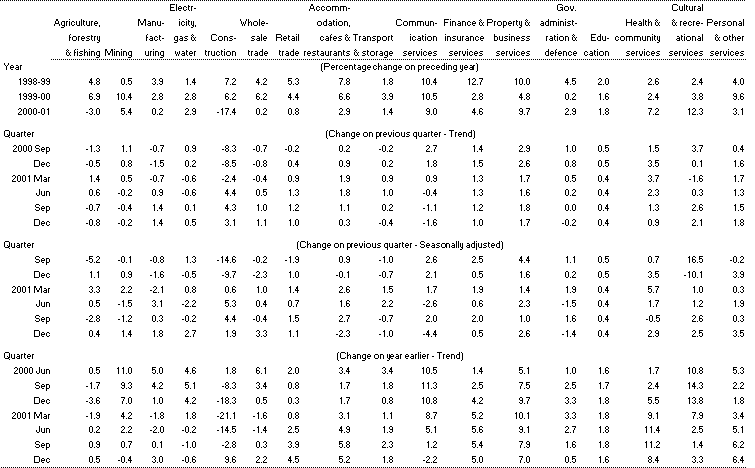
Source: ABS Cat. No. 5206.0.
Table 4: Real household income(a)
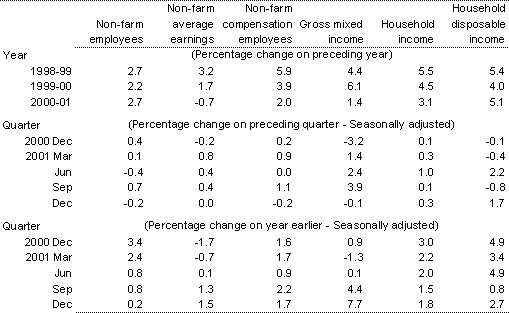
(a) Deflated by the chain price index for private final consumption expenditure.
Source: ABS Cat. No. 5206.0.
Table 5: Wages, labour costs and company income
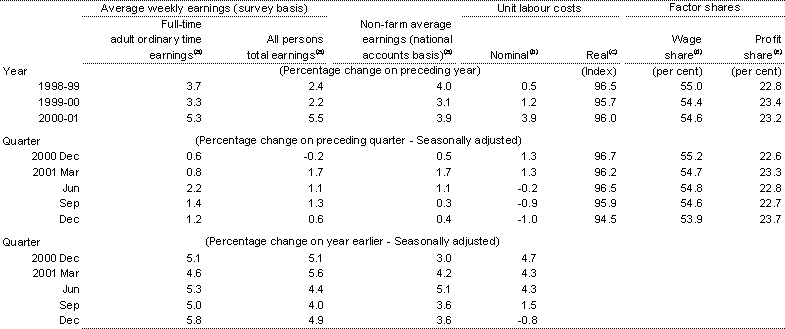
(a) All numbers derived from seasonally adjusted data.
(b) Ratio of nominal hourly labour costs (non-farm compensation of employees, plus payroll tax and fringe benefits tax less employment subsidies, per hour worked by non-farm wage and salary earners) to average hourly productivity (real gross non-farm product per hour worked by all employed persons).
(c) Nominal unit labour costs (base for index: 1986-87 = 100.0) as defined in footnote (b) deflated by the derived chain price index for gross non-farm product.
(d) Compensation of employees as a share of total factor income.
(e) Gross operating surplus of corporations as a share of total factor income.
Sources: ABS Cat. Nos. 5206.0 and 6302.0.
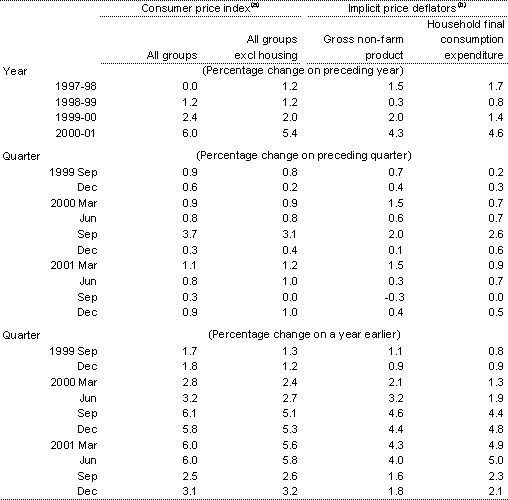
(a) Based on the weighted average of eight capital cities consumer price index.
(b) Quarterly figures are derived from seasonally adjusted data.
Sources: ABS Cat. Nos. 6401.0 and 5206.0.
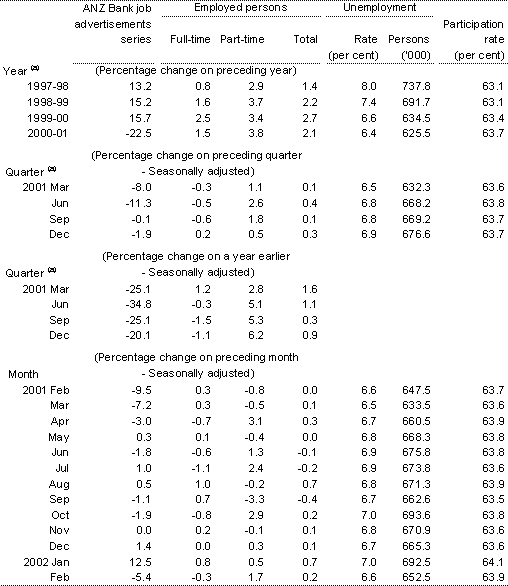
(a) All figures refer to period averages.
Sources: ANZ Bank and ABS Cat. No. 6202.0.
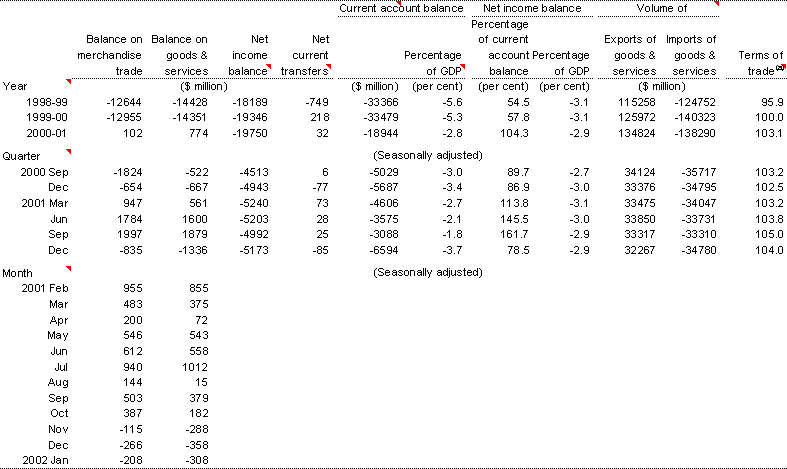
(a) The ratio of the implicit price deflator for exports of goods and services to the implicit price deflator for imports of goods and services, 1999-2000 = 100, calculated on a National Accounts basis.
Sources: ABS Cat. Nos. 5368.0, 5302.0 and 5206.0.
Table 9: Australia's external liabilities
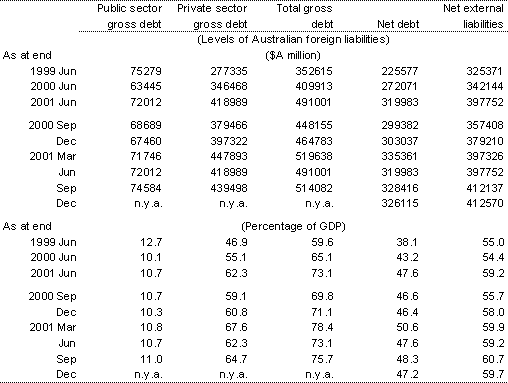
Source: ABS Cat. Nos. 5302.0 and 5206.0.
Table 10: Australia's income flows
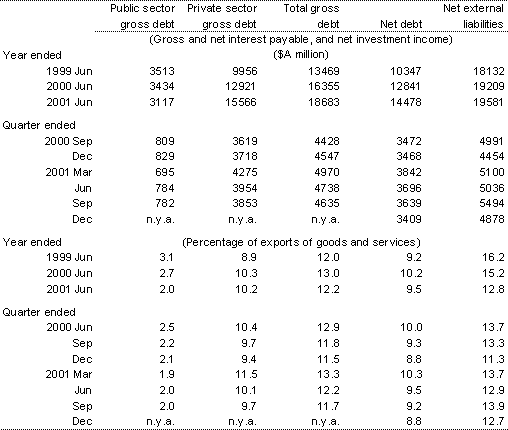
Source: ABS Cat. No. 5302.0.
Table 11: Selected economic indicators
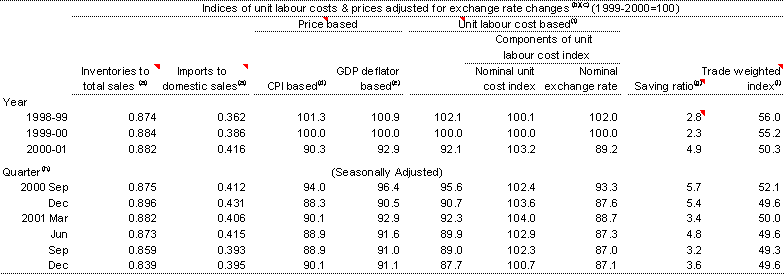
(a) ABS National Accounts measure. All numbers derived from seasonally adjusted data.
(b) A discussion of these indices and detailed figures covering the period from the September quarter 1970 to the March quarter 1983 may be found in a supplement to the July 1983 Roundup of Economic Statistics titled 'International Comparisons of Relative Price and Cost Levels'.
(c) The weights used are based on a 3 year moving average of Australia's imports from the US, Japan, UK and Germany. The four countries are the source of about 32 per cent of Australia's merchandise imports. Observations are quarterly averages. A rise (fall) implies a deterioration (improvement) in Australian costs and prices relative to the four countries above after adjusting for exchange rate changes.
(d) The CPI based index is the ratio of the Australian Consumer Price Index to the weighted geometric average of the exchange rate adjusted consumer price indices of Australia's four major import sources.
(e) The GDP deflator based index is the ratio of the GDP deflator for Australia to the weighted geometric average of the exchange rate adjusted GDP deflator of Australia's four major import sources.
(f) The unit labour cost based index is the ratio of unit labour costs in the non-farm sector of the Australian economy to the weighted geometric average of the exchange rate adjusted unit labour costs in the business sector for Australia's four major import sources.
(g) Ratio of household net saving to household net disposable income less consumption of fixed Capital.
(h) Quarterly data are seasonally adjusted except for the trade weighted index and the nominal exchange rate.
(i) Period average, May 1970 = 100.
Sources: ABS Cat. Nos. 5206.0 and 5302.0.